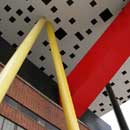Stars + Steel: OCAD
Fabrication - Weld Testing
The fabrication of the steel is a very critical part of the construction process. Where elements are welded these welds need to be tested for their integrity and strength.
Images: Walters Inc.
The weld between the round HSS leg and its conical top and bottom sections was a critical part of the design. The integrity and strength of this weld had to resist a great deal of potential horizontal shear as the Table Top would be subjected to wind and seismic loading that would put a large amount of horizontal force into the leg at its connection ends. |
|
A small test section is prepared and analyzed according to Canadian Welding Board requirements. The fabricator will wait for verification of the performance of the weld prior to using the procedure on the actual members to be included in the project. |
|
The structural integrity of the weld seam on the long pencil legs was crucial to the design. The welds were tested for strength at the Walters Inc. fabrication shop prior to the production of the legs. |
|
As the column legs would be prepared as Architecturally Exposed Structural Steel members, and the base of the leg be within range of both sight and touch by passers by, it was decided to grind the exterior of the weld smooth so that it would not show through the intumescent coating. Here we can see the results on the exterior surface. |
|
End view of the finished cone prior to subsequent incorporation into the actual leg elements. |
|
End view of the finished tubular section prior to subsequent incorporation into the actual leg elements. |
|
Understanding the final finish on the project is critical to planning the fabrication of the elements. As the legs were intended to be Architecturally Exposed Structural Steel, finished with an intumescent fire retarding coating, at a view range close to grade, it was important that the weld seam between the cone and shaft not be visible. As you can see from this image of a completed leg, the transition from the cone to the shaft is barely visible. The weld seam on the HSS member is visible but it is uniform and smooth. Given the length of the columns and the ability to orient the seam away from general view, ensuring that it was neatly done was sufficient. |
|
